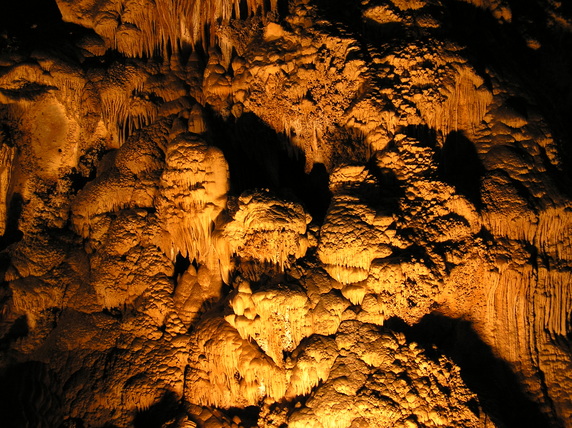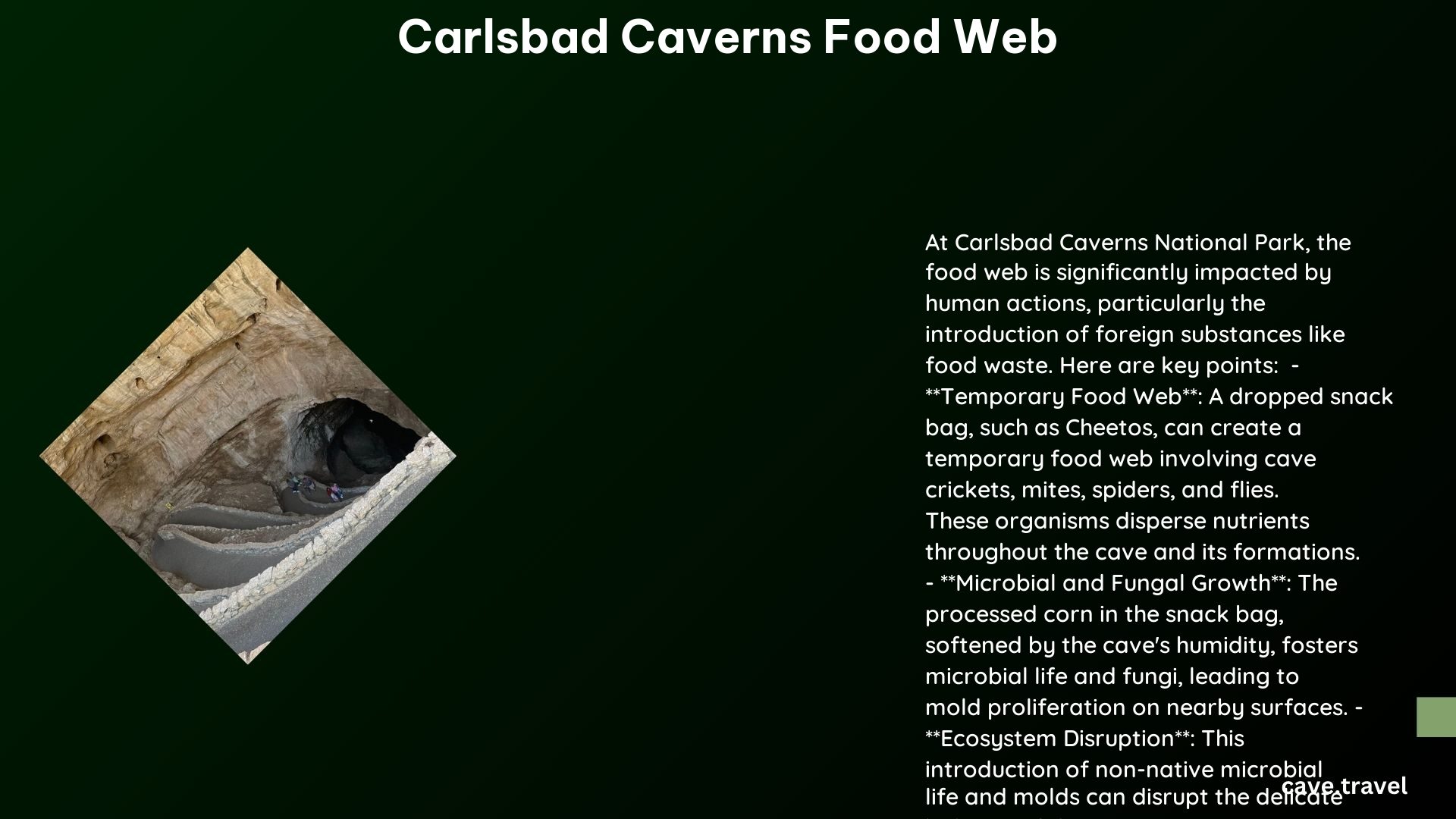The Carlsbad Caverns food web is a complex ecosystem spanning both underground and surface environments. It centers around the massive Brazilian free-tailed bat colony, which consumes vast quantities of insects nightly. The bats’ guano supports diverse cave-dwelling organisms, while surface predators and plants contribute to nutrient cycling. This interconnected system showcases the delicate balance between cave and desert habitats in Carlsbad Caverns National Park.
What Are the Key Components of the Carlsbad Caverns Food Web?

The Carlsbad Caverns food web consists of several interconnected components that span both the underground cave system and the surrounding surface ecosystem. These key elements include:
- Primary Producers
- Primary Consumers
- Secondary Consumers
- Top Predators
- Decomposers
Let’s explore each of these components in detail to understand their roles in this unique ecosystem.
What Role Do Primary Producers Play in the Carlsbad Caverns Food Web?
In the Carlsbad Caverns food web, primary producers are mainly found on the surface, as the cave environment lacks sunlight for photosynthesis. The primary producers include:
- Desert plants (e.g., cacti, yucca, agave)
- Grasses
- Shrubs
- Trees (e.g., ponderosa pine)
These plants form the foundation of the surface food web, providing energy and nutrients that eventually make their way into the cave system through various means.
How Do Primary Consumers Contribute to the Ecosystem?
Primary consumers in the Carlsbad Caverns food web can be found both on the surface and within the caves. They include:
- Surface herbivores:
- Rodents (e.g., mice, rats)
- Rabbits
- Deer
-
Insects (e.g., grasshoppers, beetles)
-
Cave-dwelling primary consumers:
- Cave crickets
- Millipedes
- Springtails
- Mites
These organisms feed on plant material, organic matter, and bat guano, playing a crucial role in nutrient cycling within the ecosystem.
What Are the Secondary Consumers in the Carlsbad Caverns Food Web?
Secondary consumers in the Carlsbad Caverns food web are primarily insectivores and small predators. Key examples include:
- Brazilian free-tailed bats
- Population: Estimated at over 1 million during peak summer months
-
Insect consumption: Up to 1,200 insects per bat per hour
-
Cave swallows
- Ringtail cats
- Raccoons
- Skunks
These animals feed on primary consumers, helping to control their populations and transfer energy up the food chain.
Who Are the Top Predators in the Carlsbad Caverns Ecosystem?
The top predators in the Carlsbad Caverns ecosystem are primarily found on the surface but play a crucial role in maintaining the overall balance of the food web. These include:
- Mountain lions (cougars)
- Bobcats
- Coyotes
- Raptors (e.g., hawks, owls)
These predators help regulate populations of smaller mammals and birds, indirectly affecting the cave ecosystem by controlling the numbers of animals that might otherwise overgraze vegetation or compete for resources.
What Is the Role of Decomposers in the Carlsbad Caverns Food Web?
Decomposers are essential to the Carlsbad Caverns food web, particularly within the cave environment. They include:
- Bacteria
- Fungi
- Microorganisms
These organisms break down organic matter, such as:
- Bat guano
- Dead plants and animals
- Organic debris washed into the caves
By decomposing this material, they release nutrients back into the ecosystem, supporting the growth of other organisms and completing the nutrient cycle.
How Does Energy Flow Through the Carlsbad Caverns Food Web?

Energy flow in the Carlsbad Caverns food web is unique due to the interaction between surface and subsurface environments. Here’s a simplified representation of the energy flow:
- Surface plants capture solar energy through photosynthesis
- Herbivores consume plants, transferring energy up the food chain
- Bats and other insectivores feed on insects, bringing energy into the cave system
- Bat guano provides energy for cave-dwelling organisms
- Decomposers break down organic matter, recycling nutrients
This energy flow creates a complex web of interactions that sustains the diverse ecosystem of Carlsbad Caverns.
What Are the Unique Adaptations of Species in the Carlsbad Caverns Food Web?
Species in the Carlsbad Caverns food web have developed various adaptations to thrive in this unique environment:
- Brazilian free-tailed bats:
- Echolocation for navigation in dark caves
-
Ability to fly long distances for foraging
-
Cave-dwelling invertebrates:
- Loss of pigmentation
- Reduced or absent eyes
-
Enhanced sensory organs for navigating in darkness
-
Desert plants:
- Water-conserving adaptations (e.g., thick cuticles, small leaves)
- Deep root systems for accessing underground water
These adaptations allow species to survive and play their roles in the food web effectively.
How Does the Surface Ecosystem Interact with the Cave Ecosystem in Carlsbad Caverns?
The surface and cave ecosystems in Carlsbad Caverns are deeply interconnected:
- Nutrient transfer:
- Organic matter from the surface enters caves through water infiltration and animal movement
-
Bat guano from cave-dwelling bats fertilizes surface vegetation
-
Species movement:
- Bats and cave swallows move between cave and surface environments daily
-
Some surface animals occasionally enter caves for shelter or foraging
-
Water cycle:
- Surface precipitation percolates through limestone, forming cave features and transporting nutrients
This interaction creates a unique and delicate balance between the two ecosystems.
What Conservation Efforts Are in Place to Protect the Carlsbad Caverns Food Web?
To protect the delicate food web of Carlsbad Caverns, several conservation efforts are in place:
- Visitor management:
- Controlled access to sensitive cave areas
-
Educational programs to raise awareness
-
Bat protection:
- Monitoring of bat populations
-
Measures to prevent the spread of white-nose syndrome
-
Surface ecosystem management:
- Fire management to maintain natural vegetation patterns
-
Control of invasive species
-
Research and monitoring:
- Ongoing studies of cave and surface ecosystems
- Long-term monitoring of key species populations
These efforts aim to preserve the unique balance of the Carlsbad Caverns food web for future generations.
References:
– https://www.nps.gov/cave/learn/management/upload/Carlsbad-Caverns-Foundation-Document.pdf
– https://whc.unesco.org/en/list/721/
– http://www.npshistory.com/publications/cave/nrr-2017-1466.pdf
